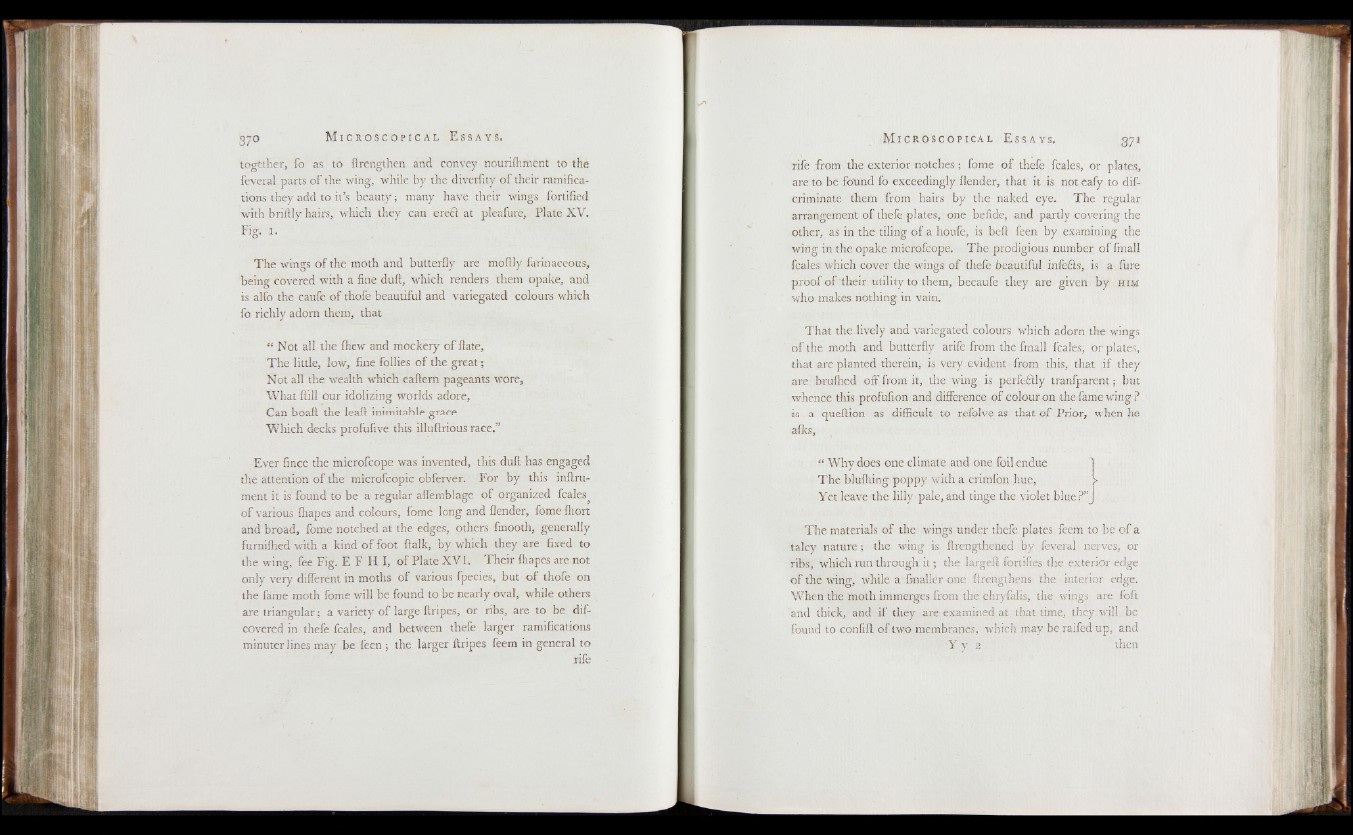
together, fo as to ftrengthen and convey nourifhment to the
feveral parts of the wing, while by the diverfity of their ramifications
they add to it’s beauty; many have their wings fortified
with briftly hairs, which they can erect at pleafure, Plate XV.
Fig. L
The wings of the moth and butterfly are moftly farinaceous,
being covered with a fine duff, which renders them opake, and
is alfo the caufe of thofe beautiful and variegated colours which
fo richly adorn them, that
** Not all the lhew and mockery o f flate,
The little, low, fine follies o f the great;
Not all the wealth which eaftern pageants wore,
What llxll our idolizing worlds adore,
Can boaft the leaf! inimitable grace
Which decks profufive this illuftrious race.”
Ever fince the microfcope was invented, this dull has engaged
the attention o f the microfcopic obferver. For by this inftru-
ment it is found to be a regular affemblage o f organized fcales^
o f various lhapes and colours, fome long and flender, fome fhort
and broad, fome notched at the edges, others fmooth, generally
furnilhed with a kind o f foot ftalk, by which they are fixed to
the wing, fee Fig. E F H I, o f Plate X V I. Their lhapes are not
only very different in moths of various fpecies, but o f thofe on
the fame moth fome will be found to be nearly oval, while others
are triangular; a variety o f large ftripes, or ribs, are to be discovered
in thefe fcales, and between thefe larger ramifications
minuter lines may be feen ; the larger ftripes feem in general to
rife from the exterior notches; fome o f thefe fcales, or plates,
are to be found fo exceedingly flender, that it is not eafy to discriminate
them from hairs by the naked eye. The regular
arrangement of thefe plates, one befide, and partly covering the
other, as in the tiling o f a houfe, is belt feen by examining the
wing in the opake microfcope. The prodigious number of fmall
fcales which cover the wings o f thefe beautiful infefils, is a fure
proof o f their utility to them, becaufe they are given by Hi.vr
who makes nothing in vain.
That the lively and variegated colours which adorn the wings
o f the moth and butterfly arife from the fmall fcales, or plates,
that are planted therein, is very evident from this, that if they
are brulhed off from it, the wing is perfeftly tranfparent; but
whence this profufion and difference o f colour on the fame wing ?
is a queftion as difficult to refolve as that o f Prior, when he
alks,
“ W hy does one climate and one foil endue
The blulhing poppy with a crimfon hue, >
Yet leave the lilly pale, and tinge the violet blue?”j
The materials of the wings under thefe plates feem to be o f a
talcy nature; the wing is ftrengthened by feveral nerves, or
ribs, which run through i t ; the large!! fortifies the exterior edge
o f the wing, while a fmaller one ftrengthens the interior edge.
When the moth immerges from the chryfalis, the wings are foft
and thick, and if they are examined at that time, they will be
found to confift of two membranes, which may be raifed up, and
Y y 2 then